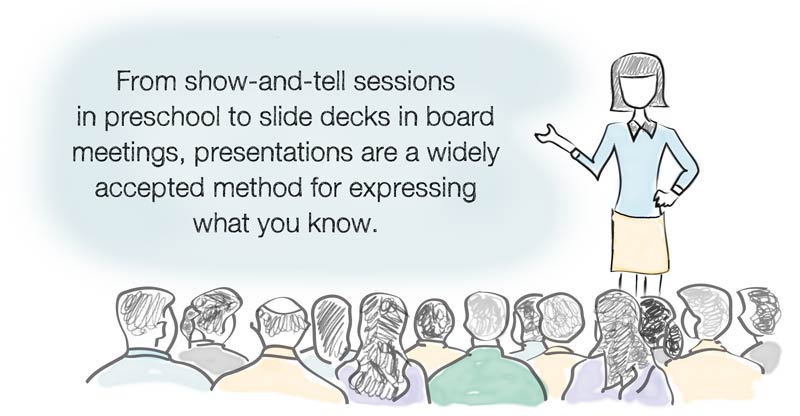RESOURCE 2
Using Presentations to Encourage Diversity

From show-and-tell sessions in preschool to slide decks in board meetings, presentations are a widely accepted method for expressing what you know. Presentations provide people with uninterrupted time to share detailed information about a topic of expertise and interest, making them important tools for self-expression. At the same time, presentations also indicate who has the most power in the room. In class, there are a few students who stand out as group leaders because they say the most in a presentation. At work, if a person is able to give a presentation at all, they are likely higher-ranking than someone who does not. In both places, those who decide the focus of the presentations and get to evaluate their worth are especially powerful. Since presentations can signal privilege and power, there needs to be concerted effort to disrupt power dynamics associated with who gets to present and what is valued.
Where Diversity Gets Lost
Presentations are often treated as displays of information, where the actual presenter fades into the background as a messenger who is able to answer the occasional question. As one of the most common forms of public speaking, there is a missed opportunity to bring human beings back to the center of presentations.
Diversity gets lost when the same people have to talk about the same thing in the same way. When this lack of diversity is solidified as an unquestioned norm in schools and workplaces, patterns of exclusion are allowed to continue.
Discussions about diversity cannot gloss over who gets to present and why, nor should they ignore who gets to be successful under current norms. Instead, discussions should examine which voices are privileged by the long-standing norms of what a presentation should look and sound like. Why is it that presentations must all look and sound the same? Even the most formal presentations should have opportunities for creativity and individuality without allowing diverse viewpoints to be stifled by the decisions of a group or restrictive evaluation criteria. In short, bringing back the humanity in presentations means asking:
- Who decides what topics are worth presenting?
- Who is a “successful” presenter and what about the context makes him succeed?
- Who is the least “successful” presenter and what about the context makes this the case?
- Who has never presented and why?
- Is there anything about the style and format of the presentations that privilege some voices over others?
- What power dynamics prevent some people from presenting effectively or even presenting at all?
- Is there variety in what presentations look and sound like? If not, why not?
- How are presentations evaluated? Do the criteria welcome diverse views and styles?
Conditions for Diversity
When rigid presentation norms are deeply entrenched in a workplace or classroom culture, it can feel virtually impossible to change them. These same norms are a barrier to diversity and also lead to lower-quality presentations. Effective presentations are infused with unique ideas and distinct viewpoints, with clear and intentional decisions about the best way to present them. There must be a good reason for presenting information in a certain way, not just because it is the way it has always been done. People in positions of power have a responsibility to shape the conditions for valuing diversity, beginning with who gets to present. Some starting points:
- Identify what expertise is valued. Are there other areas of expertise that can provide an unexpected and unusual perspective on a topic? Do not make assumptions about what people are experts in and pay attention to what people are genuinely interested in.
- Create meaningful low-stakes opportunities for people to share their expertise in any style or format they choose. The ability to choose is especially important to avoid making assumptions about people. Once shared, it is important for people to feel like their expertise was actually valued. Discuss what was surprisingly valuable information and how that knowledge might inform important shifts in thinking or work.
- Temporarily ban “traditional” formats of presentation and encourage people to think about formats that are more effective vehicles for the content, such as storytelling without slides, debates, or quick pitches with discussion. Make sure people do not resort to gimmicks or media for the sake of media. Facilitate their thinking around where the audience might get stuck and what delivery mechanisms might help clarify content.
- Actively redefine how presentations are evaluated and how people choose their presentation topics. Involve different people in defining evaluation criteria.
- Make public speaking practice sessions part of the culture. Institute peer coaching and buddy systems to share talents and expertise that might help improve everyone’s presentations. Keep an eye on power dynamics and do not position some people as better speakers than others -- make practice and improvement the norm for everyone.
- Celebrate diversity in presentations. Offer positive reinforcement to presenters who connected with their audience, provided a new way of thinking about a topic, or helped people understand a complex idea in a clear way. Encourage people to speak and think authentically, where being themselves in presentations is a good thing.
- Hold a discussion that explicitly addresses the complexities involved in being “authentic”. How can you be authentic when many institutions currently privilege some voices (and ways of speaking) over others? How can you still express yourself when the people around you do not accept who you are? How can you adapt while still being yourself and how can you push back on norms and still be heard?
The Final Takeaway
Diversity is more than making sure people from diverse backgrounds have the chance to speak. The culture itself needs to be designed and facilitated in a way that fosters diverse thinking and forms of expression. When people are forced into one model of giving presentations, it is easy to lose themselves and what they think. The point isn’t to rethink presentation formats for the sake of doing something differently. Sometimes, a single speaker with a slide deck reporting out on research is exactly what will portray the necessary information. The point is to question who gets to participate and what gets communicated when this is the only format to present ideas. Ultimately, encouraging diversity starts with disrupting the power dynamics that lie beneath something as simple as a presentation.


